FolkWorld article by Michael & Christian Moll:
Berrogüetto: A scream with success
No mysteries behind Galician music...
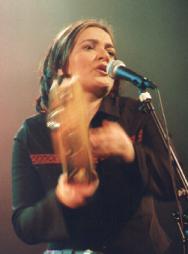 Only five years ago, a band started in Galicia with the feeling of being just a cry of a minority culture, a culture that was always second to "popular" music. As unbelievable as it is, but in these five years it all changed in Galicia: The "Scream from the Ghetto" of folk music was heard all over Spain, and today the definite number 1 in Galicia is not rock, but folk music...
Only five years ago, a band started in Galicia with the feeling of being just a cry of a minority culture, a culture that was always second to "popular" music. As unbelievable as it is, but in these five years it all changed in Galicia: The "Scream from the Ghetto" of folk music was heard all over Spain, and today the definite number 1 in Galicia is not rock, but folk music...
It was in 1995 when Matto Congrio split. This band is from this day's perspective one of the really important and innovative bands of the new Galician folk revival, mixing with their impressive line-up Galician Celtic music with influences of diverse styles and musical regions. The album of Matto Congrio from 1992 directly starts with a special version of a traditional Muiņeira in a Reggae/Folk Rock treatment, and during the rest of the 10 tunes there are lots of other surprises, including a tune featuring the uillean pipes of Paddy Moloney counterplaying against a Galician gaita.
The former members of Matto Congrio devided in 1995 in friendship, developing two new formations. Matto Congrio's gaita and flute player Carlos Núņez and the string instrumentalist Pancho Alvarez went on to form the Carlos Núņez Banda, becoming the biggest musical success that Galicia has ever seen, and paving the way for a new young and dynamic scene in Galicia.
The other three former Matto Congrios formed what is today possibly Galicia's finest live band: Berrogüetto. The three - accordionist Santiago Cribeiro, soprane saxophonist/fiddler/gaiteiro Anxo Pintos and percussionist Isaac Palacín - were joined by other musicians of famed Galician groups such as Dhais, Armeguin, Fía Na Roca, Fol de Niu: these were Quim Farinha (violin), Guillermo Fernández (guitars) and Quico Comesaņa (bouzouki, Celtic Harp). Once formed, things went off quickly - in 1996 the first, and very brilliant, CD called "Navicularia" was recorded with the Galician Do Fol record company. The next three years saw Berrogüetto playing in Galicia, in Spain, Portugal, three tours of Germany, Switzerland and Austria. With the recording of their second album, "Viaxe por Urticaria", they were joined by their seventh regular and first female member: Guadi Galego adds since then not only a new beauty spot, but also a great singing voice and skills on the tamboruine and even on the Gaita.
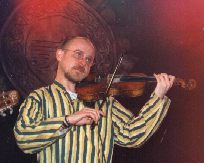 Guillermo explains the background of the band name:
Guillermo explains the background of the band name:
"Berro is a Galician word meaning scream or shout, and güetto is ghetto. So Berrogüetto is the scream of the Ghetto. In Galicia this kind of music was only second, it was not as important as rock music. So this is a scream for Galician music."
So it was only five years ago that the Galician scene needed such a scream - and this scream was highly successful, wasn't it? "Yes, more than we thought it would be doing, yes. Now things are changing in Galician music. For the first time the audience goes to concerts to see Galician bands and reacts in the same way as they would do with foreign rock bands."
These days, Galician music and Galician bands are very often the stars of folk festivals and the club circuit not only in Spain, but all over Europe. What do Berrogüetto think is the mystery behind Galician music that it is so attractive also to international audiences? - "No, no mystery! This process is involved in a whole process all over the world I think. The audiences seek for new - not for new music but new ways of making music. People seek that you come back to your roots. And I think it is for the first time that Galician music is placed in this whole process as a roots music. No, no mystery, that's important."
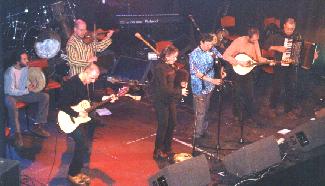 The aim of Berrogüetto is to carry the old traditional music of Galicia into our times, and the musicians show themselves very open in bringing new elements into the music. "We have no problems when we use traditional instruments with modern rhythms and with instruments like the keyboards or bass. And to use the different influences of our tradition." As diverse as their influences are the backgrounds of the band members, coming from traditional music, rock music, jazz music. And they try to use those different influences in their music.
The aim of Berrogüetto is to carry the old traditional music of Galicia into our times, and the musicians show themselves very open in bringing new elements into the music. "We have no problems when we use traditional instruments with modern rhythms and with instruments like the keyboards or bass. And to use the different influences of our tradition." As diverse as their influences are the backgrounds of the band members, coming from traditional music, rock music, jazz music. And they try to use those different influences in their music.
On the traditional side of influences, the Celtic element is strong, yet it is only one out of many influences. "The influence from other cultures is very important in our music history, because the pilgrim's way of Santiago was a very popular way in Europe. So we have in our tradition typical rhythms from the Northeast of Spain, we have waltzes, polkas, even some Latin things from South America, like tango, that has come back with the Galician emigrants coming home. It's all natural cultural influence."
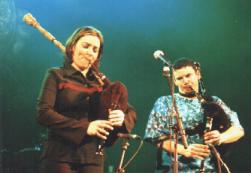 Berrogüetto use an exciting range of traditional Galician instruments. Of course there is the national instrument of Galicia, the Gaita. Then there is also a hurdy gurdy - "hurdy gurdies can be found in traditions all over the world, also in Galicia." Also the tambourine is very traditional. Fiddle was traditional in Galicia, but it was lost many years ago, "because people connected it only to the blind, to the traditional songs from blinds. There is only one recording conserved; of Florencio". (FolkWorld had a report about Florencio's music some issues ago.) These old instruments are joined with modern ones, like guitar or bouzouki or most of the percussion.
Berrogüetto use an exciting range of traditional Galician instruments. Of course there is the national instrument of Galicia, the Gaita. Then there is also a hurdy gurdy - "hurdy gurdies can be found in traditions all over the world, also in Galicia." Also the tambourine is very traditional. Fiddle was traditional in Galicia, but it was lost many years ago, "because people connected it only to the blind, to the traditional songs from blinds. There is only one recording conserved; of Florencio". (FolkWorld had a report about Florencio's music some issues ago.) These old instruments are joined with modern ones, like guitar or bouzouki or most of the percussion.
The material they play is partly traditional, partly own material. While on Berrogüetto's debut CD, more than half of the numbers were traditional, the new CD features only two traditional songs, the rest being own compositions. "We try to preserve the tradtional music, the rhythm", explains Guillermo. "But we have no problems if we have to change anything; yet our tunes are based on traditional rhythms."
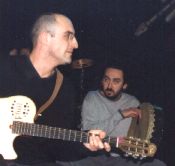 With this eclectic mix, along with an impressive, yet natural live performance, they catch an always bigger and always more mixed audience. "It is something that surprised us: Because you can see very young people, but also older ones. We think we play music that everyone can understand. It sometimes depends on the place were you play the concert. In a theatre you can find older people, but maybe in open space later in the night when you are drunk..."
With this eclectic mix, along with an impressive, yet natural live performance, they catch an always bigger and always more mixed audience. "It is something that surprised us: Because you can see very young people, but also older ones. We think we play music that everyone can understand. It sometimes depends on the place were you play the concert. In a theatre you can find older people, but maybe in open space later in the night when you are drunk..."
The title of last album of Berrogüetto has its background in the utopia of Etienne Cabet, writing in 1840 a book about an utopian village Icaria. Looking from this day's point of view, these descriptions sound not utopian at all: A town with drainage, bathrooms in the houses, retirement at 65, eight working hours a day.... Yet it took 160 years until this utopia became true.
Maybe this utopia gives a link back to the last 5 years, as in these five years an utopia was fulfilled: The utopia of folk music becoming the number one in Galicia. The ghetto from where 7 musicians screamed five years ago has become by now the majority's interest. You just have to believe in your utopias, then they might work, won't they...
Latest published CD: Berrogüetto "Viaxe por Urticaria" DoFol.
Photo Credit: All photos by the Mollis: (1) Guadi Galego; (2) Quim Farinha; (3) the whole band; (4) Guadi Galego & Anxo Pintos; (5) Guillermo Fernández & Isaac Palacín.
Back to the content of FolkWorld Articles & live reviews
To the content of FolkWorld online magazine Nr. 14
© The Mollis - Editors of FolkWorld; Published 6/2000
All material published in FolkWorld is © The Author via FolkWorld. Storage for private use is allowed and welcome. Reviews and extracts of up to 200 words may be freely quoted and reproduced, if source and author are acknowledged. For any other reproduction please ask the Editors for permission.
FolkWorld - Home of European Music

Layout & Idea of FolkWorld © The Mollis - Editors of FolkWorld
 Only five years ago, a band started in Galicia with the feeling of being just a cry of a minority culture, a culture that was always second to "popular" music. As unbelievable as it is, but in these five years it all changed in Galicia: The "Scream from the Ghetto" of folk music was heard all over Spain, and today the definite number 1 in Galicia is not rock, but folk music...
Only five years ago, a band started in Galicia with the feeling of being just a cry of a minority culture, a culture that was always second to "popular" music. As unbelievable as it is, but in these five years it all changed in Galicia: The "Scream from the Ghetto" of folk music was heard all over Spain, and today the definite number 1 in Galicia is not rock, but folk music...
 Guillermo explains the background of the band name:
Guillermo explains the background of the band name: The aim of Berrogüetto is to carry the old traditional music of Galicia into our times, and the musicians show themselves very open in bringing new elements into the music. "We have no problems when we use traditional instruments with modern rhythms and with instruments like the keyboards or bass. And to use the different influences of our tradition." As diverse as their influences are the backgrounds of the band members, coming from traditional music, rock music, jazz music. And they try to use those different influences in their music.
The aim of Berrogüetto is to carry the old traditional music of Galicia into our times, and the musicians show themselves very open in bringing new elements into the music. "We have no problems when we use traditional instruments with modern rhythms and with instruments like the keyboards or bass. And to use the different influences of our tradition." As diverse as their influences are the backgrounds of the band members, coming from traditional music, rock music, jazz music. And they try to use those different influences in their music.
 Berrogüetto use an exciting range of traditional Galician instruments. Of course there is the national instrument of Galicia, the Gaita. Then there is also a hurdy gurdy - "hurdy gurdies can be found in traditions all over the world, also in Galicia." Also the tambourine is very traditional. Fiddle was traditional in Galicia, but it was lost many years ago, "because people connected it only to the blind, to the traditional songs from blinds. There is only one recording conserved; of Florencio". (FolkWorld had
Berrogüetto use an exciting range of traditional Galician instruments. Of course there is the national instrument of Galicia, the Gaita. Then there is also a hurdy gurdy - "hurdy gurdies can be found in traditions all over the world, also in Galicia." Also the tambourine is very traditional. Fiddle was traditional in Galicia, but it was lost many years ago, "because people connected it only to the blind, to the traditional songs from blinds. There is only one recording conserved; of Florencio". (FolkWorld had  With this eclectic mix, along with an impressive, yet natural live performance, they catch an always bigger and always more mixed audience. "It is something that surprised us: Because you can see very young people, but also older ones. We think we play music that everyone can understand. It sometimes depends on the place were you play the concert. In a theatre you can find older people, but maybe in open space later in the night when you are drunk..."
With this eclectic mix, along with an impressive, yet natural live performance, they catch an always bigger and always more mixed audience. "It is something that surprised us: Because you can see very young people, but also older ones. We think we play music that everyone can understand. It sometimes depends on the place were you play the concert. In a theatre you can find older people, but maybe in open space later in the night when you are drunk..."
